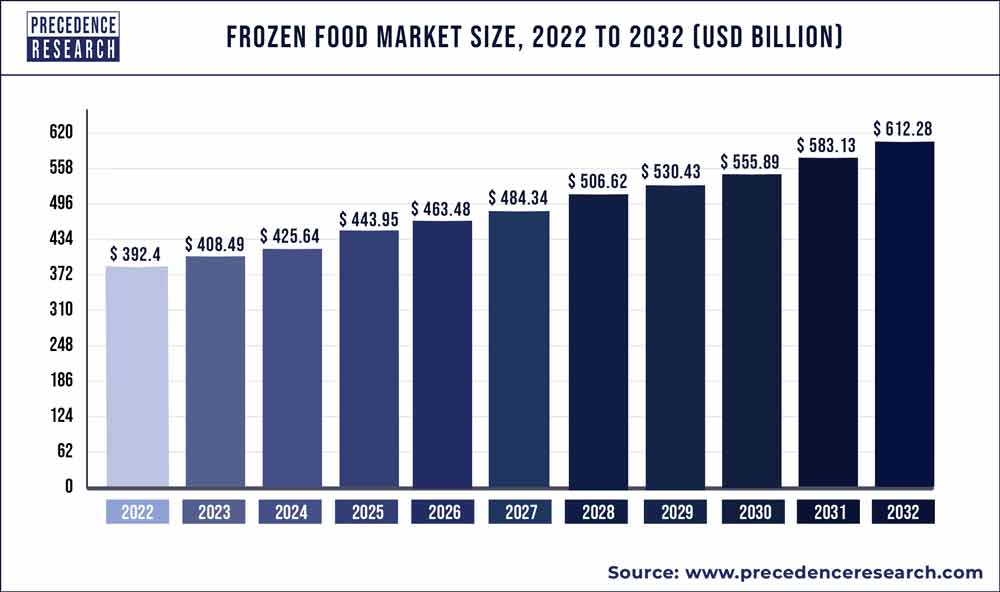- Home
- Company
- MACHINE CATEGORY
- APPLICATION CATEGORY
- Resource
- Blog
- Contact us
- Home
- Company
- MACHINE CATEGORY
- APPLICATION CATEGORY
- Resource
- Blog
- Contact us

The global frozen market is increasing as there is increasing FDI in many developing nations. The frozen products market is expected to expand in the near future. Rising demand for convenience food technological advancements in the cold chain market and the developments in retail stores are driving forces for the growth of this market.
The global frozen food market size was estimated at USD 392.4 billion in 2022 and it is projected to surpass around USD 612.28 billion by 2032 with a registered CAGR of around 4.6% from 2023 to 2032.

Cold chain logistics is an essential requirement for the storage of frozen food in all nations. Emerging nations are still lacking in the infrastructure of cold chains and are not able to provide safe products to their populace. Though these foods’ shelf life is very long, adequacy of infrastructure leads to the wastage of these food products resulting in a loss to its producers. Investments are very less in developing nations due to the financial crisis, which in turn is hampering the growth of cold chain businesses in this area. However, emerging nations have a lot of lucrative opportunities for funding on account of the changing consumer preferences towards frozen foods and the increasing acceptance of them.
According to Nielsen Market Research Company, frozen and shelf-stable foods were prominent in shopping carts during the COVID-19 pandemic. Consumers stocked up on these food items which helped to reduce the number of trips they needed to make to the grocery store. Nielsen data shows that frozen foods were in the top five food categories with significant sales growth from March to June 2020
While some consumer purchasing habits, such as buying frozen products, may extend beyond the pandemic, other factors may also influence frozen food sales in the future. The impact of the pandemic, and therefore the impact on purchasing power, is not equal among consumer groups. Financially impacted consumer groups may adopt new shopping strategies, for instance, some may opt for more frozen foods over fresh foods to reduce costs. Apart from pandemic impacts, frozen food is one of the most convenient ways for consumers to find meal solutions. In recent years, food manufacturers have given the frozen food category a sharper focus by developing a greater number of tasty and nutritionally-rich products. Given these facts, it is worth getting some insights into frozen food sales trends in Alberta. Such analysis could help Alberta food processors pursue potential opportunities in frozen food manufacturing.
General Mills Inc (US)
Conagra Brands, Inc. (US)
Grupo Bimbo S.A.B. de C.V. (Mexico)
Nestle SA (Switzerland)
Associated British Foods plc (UK)
Ajinomoto (Japan)
Vandemoortele NV (Belgium)
LantmannenUnibake International (Denmark)
Cargill (US).
Unilever (Netherlands)
Kellogg Company (US)
McCain Foods Limited (Canada)
Kraft Heinz Company (US)
Product research - Thoroughly research what types of frozen foods are in demand and what gaps exist in the market. Test recipes to find your niche.
Food safety compliance - Ensure your facility, processes and products meet all food safety regulations. This is critical for building customer trust.
Facility and equipment - You'll need commercial freezer space and machinery suited for scaling production. Consider co-packing options initially.
Recipes and packaging - Develop your recipes and source packaging materials approved for frozen storage and microwave/oven reheating.
Distribution strategy - Decide how you'll get products to customers - direct store delivery, broadline distributors, online sales etc.
Branding and marketing - Create a brand identity and promotional plan to engage customers and gain market visibility.
Financial planning - Create realistic sales forecasts and budgets. Consider sources of startup capital like loans, grants or crowdfunding.
Team building - Assemble key talent in areas like product development, operations, sales and financial management.
Food safety program - Implement proper controls and recordkeeping for food safety, temperature control and supplier management.
Starting small and prioritizing food safety compliance will help establish a solid foundation for your frozen food business.